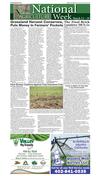9
Broadcaster Press 9
March 15, 2016 www.broadcasteronline.com
National Ag Week
Thank a
Farmer Today!
March 13 ~ 19, 2016
Financing Beginning Farmers SDSU Entomologist Discovers New
PIERRE – Bond purchasers can
finance a beginning farmer.”
Insect Species On Prairie Cordgrass
potentially save thousands of dollars
Typically the Beginning Farmer
in federal taxes by investing in a
beginning farmer.
Through the Beginning Farmer
Bond program, the South Dakota
Value Added Finance Authority (VAFA)
issues tax-exempt bonds for qualifying
beginning farmers to purchase
agricultural land at lower interest
rates. The limit on a beginning farmer
bond is $520,000.
“To be eligible for the program,
an applicant must be at least 18
years old, a resident of South Dakota,
have a net worth under $400,000
and own less acres than 30% of
the county median,” says Terri
LaBrie, South Dakota Department of
Agriculture finance administrator.
“The bond program is a great way
for a beginning farmer to buy land.
It’s also advantageous for a retiring
farmer willing to enter into a contract
for deed with that beginning farmer or
an individual investor looking to help
Bond program works through a local
lender. However, if a retiring farmer
is interested in passing on his or her
land to a beginner farmer, the interest
from that contract sale is federally
tax exempt-- providing administers
the Beginning Farmer Bond program
through the Value Added Finance
Authority board. The board meets
monthly and reviews the applications
for the program and issues the
bonds for approved projects. Board
members include: Bob Hull, Sisseton;
Mark Gross, Sioux Falls; Jim Schmidt,
Lennox; Chuck Jepson, Ft. Pierre;
Jim Doolittle, Belle Fourche; Marcia
Hendrickson, Chancellor; and Nathan
Jensen, Beresford.
For information on the financial
programs offered through SDDA,
please contact one of the board
members or Terri LaBrie, finance
administrator, at 605.280.4745 or
terri.labrie@state.sd.us.
SOUTH DAKOTA 2015 CROP
PRODUCTION SUMMARY
SIOUX FALLS, SD - Corn
for grain production is
estimated at 800 million
bushels, up 2 percent
from 2014 according
to the USDA’s National
Agricultural Statistics
Service. The average
yield is estimated at 159
bushels per harvested
acre, up 11 bushels from
last year, and is a new
record high surpassing
the previous high of
151 bushels per acre in
2009. Area harvested
for grain, at 5.03 million
acres, is down from last
year’s 5.32 million acres.
Soybean production
is estimated at a
record high 236 million
bushels, up 2 percent
from last year’s previous
high. The average yield
is estimated at 46.0
bushels per harvested
acre, a new record
high, and exceeds the
previous high by 1.0
bushels established
just last year. Acres
harvested are estimated
at 5.12 million, again a
record high surpassing
last year’s 5.11 million
acres harvested.
Alfalfa hay
production, at 4.18
million tons, is down 4
percent from 2014. Yield
is estimated at 2.20 tons
per acre, down 0.10 tons
per acre from a year
ago. Acres harvested
are estimated at 1.90
million, unchanged
from last year. All other
hay production totaled
2.40 million tons, up 5
percent from last year.
Yield is estimated at
1.60 tons per acre, down
0.10 tons per acre from
last year. Harvested
acres are estimated at
1.50 million, up from
1.35 million acres last
year. New seedings of
alfalfa in 2015 totaled
120,000 acres, down
from 150,000 acres a
year ago. Total forage
3x
...the Value
For Your Classified!
605-624-4429
production from alfalfa
and other hay was
6.84 million tons in
2015, down less than
1 percent from a year
earlier.
Sorghum for grain
production is estimated
at 18.3 million bushels,
up 93 percent from last
year. Yield is estimated
at 83 bushels per acre,
up 20 bushels from last
year, and establishes a
new record surpassing
the previous high yield
of 80 bushels per acre in
2013. Acres harvested
are estimated at
220,000, up from 150,000
acres harvested a year
ago.
Oil sunflower
production is estimated
at 1.05 billion pounds,
up 57 percent from
last year. Yield is
estimated at a record
high 1,840 pounds per
acre, up 170 pounds
from the previous
year, surpassing the
previous high of 1,800
pounds per acre in 2009.
Acres harvested are
estimated at 570,000, up
from 400,000 acres last
year. Non-oil sunflower
production is estimated
at 181 million pounds,
down 13 percent from
a last year’s record
production. Yield is
estimated at a record
high 1,970 pounds per
acre, up 260 pounds
from last year, and
eclipses the previous
record yield of 1,800
pounds per acre in
2009. Acres harvested
are estimated at 92,000,
down from last year’s
record high 122,000
acres harvested.
Proso millet grain
production is estimated
at 1.89 million bushels,
down 12 percent from
a year ago. Yield is
estimated at 31 bushels
per acre, unchanged
from a year earlier.
Harvested acres are
estimated at 61,000,
down from 69,000 acres
harvested in 2014.
Dry edible bean
production is
estimated at 205,000
hundredweight, down
16 percent from 2014.
Yield is estimated at
1,770 pounds per acre,
down 110 pounds
from last year. Acres
harvested are estimated
at 11,600, down from
12,900 acres harvested
a year ago.
Flaxseed production
is estimated at 288,000
bushels, up 220 percent
from 2014.
Yield per harvested
acre is estimated at 16
bushels, down 2 bushels
from last year. Acres
harvested are estimated
at 18,000, up from 5,000
acres a year ago.
Access this complete
report at:
http://usda.mannlib.
cornell.edu/usda/
BROOKINGS - A newly
discovered insect
species in prairie
cordgrass may explain
why increasing seed
production has been
so difficult, according
to South Dakota State
University entomologist
Paul J. Johnson, a
professor in the plant
science department.
He and graduate
student J. Manuel Perilla
López found a new
species of gall midge
in prairie cordgrass at
four locations in eastern
South Dakota, including
the Oak Lake Field
Station. The research
was supported primarily
by the U.S. Department
of Agriculture through
the North Central
Regional Sun Grant
Center which seeks to
develop native grasses
as a source of biobased
transportation fuels.
The prairie cordgrass
gall midge has a different
relationship with its host
plant than other species
of gall midge, which
form a pocket called a
gall within plant tissues,
Johnson explained.
“This species feeds on
the seeds but doesn’t
modify the plant itself.
That’s a new discovery
in itself.”
The adult gall midge,
which is about half the
size of a fruit fly, lays its
eggs in the plant when it
begins to flower in mid
to late July, according
to Johnson. The larvae
Graduate student J. Manuel Perilla Lopez examines prairie cordgrass at the Felt farm north of the SDSU campus. He documented
a new species of gall midge that feeds on the seeds of this native grass. He completed his master’s degree in December 2015.
feed on the developing
seed within the plant.
“Depending on when the
eggs hatch, the larvae
will even feed on the
unfertilized ovule.”
However, when the adult
lays its eggs too late,
the larvae don’t develop
to adult stage because
the developing seed
has become too hard,
Johnson explained.
“They don’t have
mandibles, so must suck
the juice of the plant.”
Sun Grant director Vance
Owens said this research
is important because
“seed production has
always been a significant
issue with prairie
cordgrass.”
Commercial
companies have had
problems with prairie
cordgrass, in particular,
Johnson noted. “Though
the demand is high,
it’s costly to grow and
produces very few seeds.
Now, we have an idea of
what’s causing that loss.”
Johnson and López
also discovered a
possible solution to the
problem—a parasitic
wasp that feeds on the
gall midge larvae but
n PRAIRIE CORDGRASS,
Page 12
Key Facts: SD
South Dakota is home to over
31,000 farm and ranch families who
work daily to ensure a safe and
affordable product for consumers
across the world. 98% of the farms in
South Dakota are family owned and
operated, with the average size of a
farm being 1,395 acres.
Agriculture is South Dakota's
number one industry with more than
a $21 billion economic impact each
year. Agriculture employs over 115,000
South Dakotans and contributes more
than $645 million to the state's tax
revenues. In 1940 the average farmer
fed 19 people. However, thanks to
today's agriculture, the average farmer
is able to produce more on fewer
acres of land and is able to feed 155
people. The continued advancement
in technology is important in order
to feed a growing population of more
than 9 billion people by 2050.
While a lot has changed in
agriculture over the years, one thing
remains the same and that is the
farm families dedicated to providing
quality care to the land, animals and
environment as well as a safe and
affordable product for families all over
the world to enjoy.
SPRING IS HERE!
-Licensed
-Bonded
-Insured
Wakonda, SD • 605-267-2768 • Cell: 605-661-1063
LONG REACH EXCAVATOR
WITH 65’ OF REACH
Give us a call for a quote …
Laser Guided Ditching
Stock Dam Cleanout
Lagoon Cleanout • Bank Stabilization
Rip Rap Placement • Demolition
Bill Andersen
to handle all your
Bulk Fuel and Oil Operations
and delivery to
your farm, field, or home!
? Home Heating Fuel
? #1 & #2 Clear and Dyed Fuels
? No Lead or E10 Gasolines
Please Call 605-326-6801 or 563-2345
To receive our updated prices electronically:
Please email LockwoodOil@hotmail.com or text 605-430-1890

















 Previous Page
Previous Page





